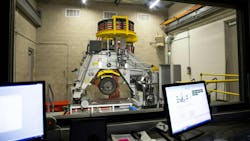Are electric vehicle (EV)-specific tires tested differently than traditional tires? What does the process look like? What kind of equipment is involved?
In this MTD exclusive, Cliff Hodges, technical director, Smithers Tire and Wheel Test Center, and Eric Pierce, senior engineer, Smithers Winter Test Center, discuss EV tire evaluation.
MTD: It's well-known that EVs, by virtue of their design, put additional stress on tires (ex: added weight, instant torque, etc.) How do you incorporate these factors into testing, both in lab and on the track?
Hodges: EV design and dynamics challenge the tires in some different ways versus internal combustion engine (ICE) vehicles. Additional load and different load distributions can affect tire grip, treadwear, durability, flat spotting, rolling resistance and other performance criteria and higher torque levels will certainly affect grip and treadwear. In addition, without vehicle engine noise, all interactions with the road can increase the consumer’s awareness of noise and vibrations in the cockpit.
In the vehicle development process, tires are designed around specific vehicle attributes. Hence, the more advanced the vehicle, the more robust testing protocols required to fully quantify the tire’s performance. Additionally, current testing technology must be advanced enough to test under regulatory conditions, such as FMVSS standards. Traditional testing machine technologies have withstood the test of time and are still required for regulatory purposes. For example:
Rolling resistance. Because of the desire to maximize range on EVs, rolling resistance of the tires on the vehicle has been a big piece of the puzzle. There are standard test methods for rolling resistance that are still used for EVs. However, it has been studied and well-understood that EV batteries are less effective in cold temperatures, (thereby) reducing range. Smithers has recently added the ability to test tire rolling resistance under various temperatures. Initial studies have shown that tire rolling resistance is also challenged at lower temperatures, creating opportunities for tire makers and vehicle OEMs to work on strategies to improve cold-weather performance and extend battery range during winter months.
High-speed uniformity. The uniformity of a tire can affect noise, vibration, and harshness (NVH) throughout the vehicle. Reducing NVH has become a key target for tiremakers. In addition, heavy EV batteries put increased load on EV tires, which can cause flat-spotting issues when vehicles are parked for lengthy periods. The high-speed uniformity machine can validate tires to all these parameters. Additionally, cleats can be added to the drum to understand how impacts can affect durability and performance of EV tires.
Force and moment (F&M) testing. The higher loads on EV tires can be supported within various test methods that also provide critical data to tire models that can help EV platform development engineers dial in their designs through simulations.
On the proving ground, traditional testing is still being done, but because these platforms and performance requirements have shifted, validations on more subjective characteristics like handling and understanding noise and vibration performance have become even more critical.
The other unrelated adjustment to our proving ground testing has been simply accommodating the chargers needed to test the influx of EVs coming on-site. Power requirements and specific charging technologies are required to ensure that testing can be done as efficiently as possible.
The Smithers Tire and Wheel Test Center in Ravenna, Ohio, is equipped with highly customizable tire testing machinery that can recreate the unique stresses of an EV tire. EVs have incredibly heavy batteries, which puts an increased load on tires. This can be simulated in a laboratory environment by increasing the load on an F&M or rolling resistance testing machine.
Pierce: Aside from on-vehicle testing using EVs, there are a few ways to compensate for the high mass of an EV vehicle when conducting snow and ice traction testing on an EV tire. The first is to conduct testing with a high-load traction truck. If a high-traction truck is not available, the air pressure in the tire can be adjusted before testing to compensate.
MTD: Has Smithers devised special testing procedures and machinery for EV tires or can EV tires be tested in the same manner - using the same equipment and processes - as non-EV tires? Why or why not?
Hodges: EV tires and non-EV tires can be tested with the same testing equipment. However, testing parameters for EV tires are often different. Rolling resistance and F&M testing for an EV tire will be conducted at a higher load to simulate the tremendous weight of an EV battery. Indoor tread wear testing is also conducted at a higher load.
Pierce: Smithers has invested in a new high-load snow traction testing truck at the Smithers Winter Test Center to support snow and ice traction testing for EV tires. Our high-load traction truck can generate loads up to 2,800 pounds on a test tire.
Outside of whole-tire testing, compounders have ramped up tread development as raw material suppliers and tire manufacturers attempt to find a better mix for the ‘magic triangle,’ consisting of rolling resistance, wet grip and treadwear. Rolling resistance plays a large part in extending range and high torque from EVs can wear tires quicker, driving a need to improve customer satisfaction with tire performance.
MTD: Does it take longer to test EV-specific tires than traditional tires or vice versa? Why or why not?
Hodges: From a regulatory standpoint, standardized testing for ICE and EV tires takes roughly the same amount of time. However, tire OEMs may spend more time on R&D testing for EV tires. Electric vehicles put different stressors on tires than vehicles with internal combustion engines and developing a tire that performs as expected under those conditions may require several rounds of testing and iteration.
MTD: Has Smithers experienced an uptick in requests from tiremakers to test EV tires and if so, do you expect this to continue?
Hodges: Smithers is seeing an uptick in requests for EV tire testing at our various global laboratories across the full supply chain. Because so many elements are being affected, we see interest in understanding performance parameters from material development for tread formulations to whole tire performance testing in the lab to on-vehicle testing at the proving ground. As global demand for EVs grows and tire makers are increasing SKUs around EV tires, we expect this trend to continue.
The automotive market is also seeing an increase in EV start-ups developing brand-new vehicle platforms. These companies have had to build their in-house tire and vehicle integration expertise and thus are turning to independent testing and consulting companies, such as Smithers, for support.
Because we have been supporting the tire and automotive industry for nearly 100 years - our anniversary is in 2025 - our in-house experts provide a broad scope of expertise across the supply chain that is ideally suited to support these types of development teams. By working closely with each of these start-up groups, we can often develop custom testing programs to help support specific development requirements that improve time to market.
OE-specific tires are only one piece of the market, however. As more and more of these EV- specific tires come to the aftermarket, tire distributors, dealers and consumers alike want to better understand why these tires are different and how they will perform with their newly purchased EV. We also see a demand for independent, third-party evaluations of the tires entering the market so that these distributors can provide better information to their customers as they attempt to make choices about what’s best for their vehicles and driving styles.
About the Author
Mike Manges
Editor
Mike Manges is Modern Tire Dealer’s editor. A 28-year tire industry veteran, he is a three-time International Automotive Media Association Award winner, holds a Gold Award from the Association of Automotive Publication Editors and was named a finalist for the prestigious Jesse H. Neal Award, the Pulitzer Prize of business-to-business media, in 2024. He also was named Endeavor Business Media's Editor of the Year in 2024. Mike has traveled the world in pursuit of stories that will help independent tire dealers move their businesses forward. Before rejoining MTD in 2019, he held corporate communications positions at two Fortune 500 companies and served as MTD’s senior editor from 2000 to 2010.

